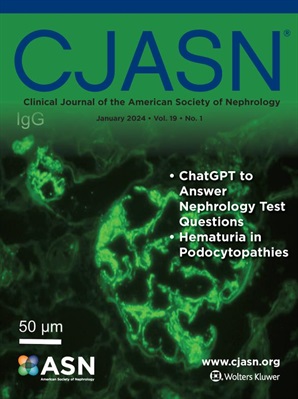Bioimpedance-Guided Fluid Removal in Continuous Kidney Replacement Therapy: The VENUS Randomized Clinical Trial.
IF 8.5
1区 医学
Q1 UROLOGY & NEPHROLOGY
Clinical Journal of the American Society of Nephrology
Pub Date : 2024-09-12
DOI:10.2215/cjn.0000000000000557
引用次数: 0
Abstract
BACKGROUND Ultrafiltration with continuous kidney replacement therapy (CKRT) can be used to manage fluid balance in critically ill patients with acute kidney injury (AKI). We aimed to assess whether bioimpedance analysis (BIA)-guided volume management was more efficacious than conventional management for achieving estimated euvolemia (e-euvolemia) in CKRT-treated patients. METHODS In a multi-center randomized controlled trial from July 2017 to July 2020, the patients with AKI requiring CKRT were eligible if the weight at the start of CKRT had increased by ≥5% compared to the weight at the time of admission, or total body water (TBW)/ height (H)2 ≥13 L/m2. We randomly assigned 208 patients to the control (conventional fluid management; N=103) and intervention groups (BIA-guided fluid management; N=105). Primary outcome was the proportion of attaining e-euvolemia seven days post-randomization. E-euvolemia was defined as the difference between TBW/H2 D7 and D0 was <-2.1 L/m2, or when TBW/H2 measured on D7 was <13 L/m2. The 28-, 60-, and 90-day mortality rate were secondary outcomes. RESULTS The primary outcome occurred in 34 patients in the intervention group and 27 in the control group (47% versus 41%; P=0.50). The mean value of TBW/H2 measured on D7 was the same at 13.9 L/m2 in both groups. The differences between TBW/H2 D7 and D0 were -1.13 L/m2 in the intervention group and -1.08 L/m2 in the control group (P=0.84). Patients in the intervention group had a significantly higher proportion of reaching e-euvolemia on D1 than those in the control group (13% versus 4%, P=0.02). Adverse events did not differ significantly between the groups. CONCLUSIONS BIA-guided volume management did not affect the proportion of reaching the estimated euvolemia at seven days of the start of CKRT. TRIAL REGISTRATION ClinicalTrials.gov, ID: NCT03330626 (Registered on 6 November 2017; Seven study participants were retrospectively registered; nonetheless, IRB approval of each institution was completed before study participant registration).连续性肾脏替代疗法中的生物阻抗引导液体清除:VENUS 随机临床试验。
背景持续肾脏替代疗法(CKRT)超滤可用于管理急性肾损伤(AKI)重症患者的体液平衡。我们旨在评估生物阻抗分析(BIA)指导下的容量管理在实现 CKRT 治疗患者的估计无容量血症(e-euvolemia)方面是否比常规管理更有效。方法在 2017 年 7 月至 2020 年 7 月期间进行的一项多中心随机对照试验中,需要接受 CKRT 的 AKI 患者,如果开始接受 CKRT 时的体重与入院时相比增加了≥5%,或体内总水分(TBW)/身高(H)2 ≥13 L/m2,则符合条件。我们将 208 名患者随机分配到对照组(常规液体管理;103 人)和干预组(BIA 指导下的液体管理;105 人)。主要结果是随机分配后七天内达到电子浮量血症的比例。E-euvolemia 的定义是 D7 天的 TBW/H2 与 D0 天的 TBW/H2 之差小于 2.1 L/m2,或 D7 天测量的 TBW/H2 小于 13 L/m2。28、60 和 90 天的死亡率为次要结果。结果干预组有 34 名患者出现主要结果,对照组有 27 名患者出现主要结果(47% 对 41%;P=0.50)。两组患者在 D7 测得的 TBW/H2 平均值相同,均为 13.9 L/m2。干预组 D7 和 D0 的 TBW/H2 差值为-1.13 升/平方米,对照组为-1.08 升/平方米(P=0.84)。干预组患者在 D1 时达到电子血容量的比例明显高于对照组(13% 对 4%,P=0.02)。结论BIA指导下的容量管理不会影响CKRT开始7天后达到估计e-euvolemia的比例:NCT03330626(注册日期:2017年11月6日;7名研究参与者为回顾性注册;尽管如此,各机构的IRB审批已在研究参与者注册前完成)。
本文章由计算机程序翻译,如有差异,请以英文原文为准。
求助全文
约1分钟内获得全文
求助全文
来源期刊
CiteScore
12.20
自引率
3.10%
发文量
514
审稿时长
3-6 weeks
期刊介绍:
The Clinical Journal of the American Society of Nephrology strives to establish itself as the foremost authority in communicating and influencing advances in clinical nephrology by (1) swiftly and effectively disseminating pivotal developments in clinical and translational research in nephrology, encompassing innovations in research methods and care delivery; (2) providing context for these advances in relation to future research directions and patient care; and (3) becoming a key voice on issues with potential implications for the clinical practice of nephrology, particularly within the United States. Original manuscript topics cover a range of areas, including Acid/Base and Electrolyte Disorders, Acute Kidney Injury and ICU Nephrology, Chronic Kidney Disease, Clinical Nephrology, Cystic Kidney Disease, Diabetes and the Kidney, Genetics, Geriatric and Palliative Nephrology, Glomerular and Tubulointerstitial Diseases, Hypertension, Maintenance Dialysis, Mineral Metabolism, Nephrolithiasis, and Transplantation.

 求助内容:
求助内容: 应助结果提醒方式:
应助结果提醒方式:


